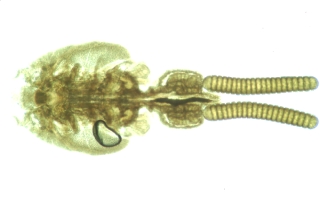 Caligus sp.
Caligus sp.
 Caligus sp.
Caligus sp.
Tilapia reared in brackish to saltwater often are infected my a marine parasitic copepod Caligus sp. Heavy infestations of tilapia by Caligus sp. have been recognized particularly when tilapia have been monocultured in tanks or ponds and wild caught fish have been introduced into the tilapia populations. Without the presence of small copepod predators, populations of Caligus sp. can explode resulting in very heavy infestations (> 50 copepods per fish). In tilapia Caligus sp. is found on the skin but does not attack the gills of the fish.
Caligus sp. has multiple stages in its life cycle. The adult stage is a parasite on fish. In Hawaii, tilapia are not the natural host for Caligus sp., however, tilapia are highly susceptible to colonization by this parasite. Mature female Caligus sp. have prominent strands of eggs that trail behind the parasite. The eggs hatch to release free swimming, non-parasitic stages (two or three) of the copepod. The infective stage attaches to a fish host. The free swimming stages of Caligus sp. are susceptible to predation by small fish (e.g. topminnows, Aholehole etc.).
Tilapia affected by heavy Caligus sp. infestation display characteristic abnormal behavior. The tilapia may gather in a group and lay or lean against each other. This behavior is called "piling". Unless disturbed, individual fish will stay motionless with fins clamped against the body. Some tilapia may have sores or ulcers in groups heavily infected by Caligus sp. Usually, these wounds are shallow, scooped out appearing ulcerations with muscle exposed and clean edges.
Caligus sp. are readily visible to the naked eye. The organism will be flattened against the body and are often olive green in color. Individual Caligus sp. are 2 to 3 mm in length and will scoot along the surface of the fish if disturbed. Microscopically Caligus sp. look like "lice" with two eye spots on the head. Often, females will have two egg cases attached to the posterior end of the parasite. A diagnosis of Caligus sp. infection can be made by gross examination and demonstration of the characteristic copepods on the skin of the affected tilapia.
Often the Caligus sp. will move when an infected fish is held out of water and in heavy infections the skin may appear to "shimmer".
Caligus sp. found to affect tilapia in Hawaii does not tolerate prolonged exposure to freshwater. Thus, one means of control is to reduce the salinity of the water to zero and hold the fish in freshwater for a week or more. Treatment with copper sulfate or masoten may also be effective, but these chemicals have not been approved by the FDA for use with tilapia. Polyculture of tilapia with Aholehole or topminnows is an effective means to reduce but not eliminate Caligus sp.
Wild caught tilapia, mullet or other marine species should not be transferred directly into enclosed tanks used to culture tilapia. These fish should be first acclimatized to freshwater for a week or more and then readjusted to brackish or saltwater before being transferred into tanks with the captive groups of tilapia.
Not exactly the same type, but shows the motion and how it feeds.
+
| file: /Techref/other/pond/tilapia/caligus.htm, 3KB, , updated: 2014/7/18 12:46, local time: 2025/5/9 23:31,
3.14.132.123:LOG IN
|
| ©2025 These pages are served without commercial sponsorship. (No popup ads, etc...).Bandwidth abuse increases hosting cost forcing sponsorship or shutdown. This server aggressively defends against automated copying for any reason including offline viewing, duplication, etc... Please respect this requirement and DO NOT RIP THIS SITE. Questions? <A HREF="http://sxlist.com/Techref/other/pond/tilapia/caligus.htm"> Tilapia Topic: Disease Vectors</A> |
| Did you find what you needed? |
Welcome to sxlist.com!sales, advertizing, & kind contributors just like you! Please don't rip/copy (here's why Copies of the site on CD are available at minimal cost. |
Welcome to sxlist.com! |
.